Chapter 8: Control of
Fundamental Frequency

Equation 8.1. This equation derives
the natural frequency of a simple mass-spring
oscillator, of mass m and with a stiffness
of k. The frequency is proportional to
the square root of the ratio of stiffness to
mass.
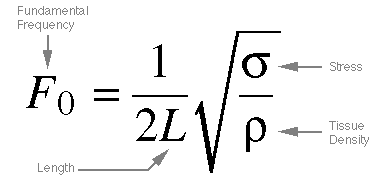
Equation 8.2. Similar
to the first; it gives the natural frequency of an "ideal string",
given its density, length, and the stress put
on it.
However, determining the stiffness of vocal
folds is rather more complex; they behave partly
like strings and partly like springs. The following
three equations help determine the effective
stiffness of vocal folds:
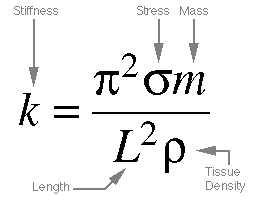
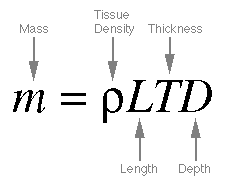
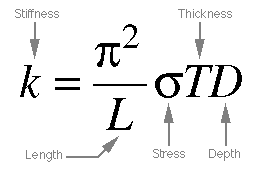
Equations 8-3, 8-4, and 8-5. Equation
8-3 is derived from 8-1 and 8-2, by equating
the two fundamental frequencies (left sides of
the equations), and then re-arranging remaining
terms. 8-4 gives us the vocal fold mass,
which is the amount of the vocal fold material
that is effectively vibrating (the entire
fold is not always in vibration). Finally, combining
8-3 and 8-4 gives us the effective stiffness,
which is directly proportional to the vocal fold
tension.
Equation 8.6: Vocal Fold Elongation. The
length change in the vocal folds (strain) is
given here. G, a gain factor, describes
the range of stretching that can be achieved
with CT and TA activity. R is a quantity
which accounts for the mechanical advantage that
the CT muscle has over the TA. The minus sign
in the equation shows that the actions of the
CT and TA are in opposition; the TA tries to
shorten the folds, whereas the CT tries to lengthen
them.
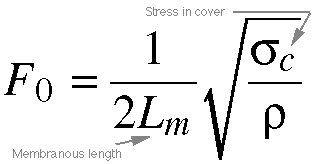
Equation 8.7. Here
we have an equation to find the Fo of
the cover of the vocal folds. It's identical
to 8-2 above, except that the variables for stress
and length are slightly renamed to show that
it's just the cover we're talking about now,
as opposed to the entire fold.

Equation 8.8. This last one gets a bit
hairy, but if broken down into parts, it's not
so bad. It's more complex because it takes into
account a more sophisticated model of the vocal
folds called the body-cover model. [It
may also help to review the Body-Cover
Model tutorial.] The simpler cover model is
adequate to explain some frequency ranges and
conditions, but it fails to account for the fact
that TA muscle activity can both increase and
decrease Fo. The reason for this is
that part of the vocal fold body, the TA muscle
itself, is vibrating when you produce low pitches
or do especially loud singing.
Since the cover model accounts only for the
cover and not the body, it makes sense that it
would not explain situations involving activity
in both the body and the cover. The entire part
of the equation to the right of the square root
sign is added in to account for TA activity.
Note that if you set aTA to 0, this
part of the equation evaluates to 1 (zero times
anything is zero, plus 1 is 1, and 1 to the 1/2
power is the square root of 1, which is also
1), and thus drops out entirely, leaving a n
equation just like 8.7, the cover model equation.
The da/d part of the equation is
the ratio of the depth of the TA muscle
that is vibrating to the depth of all tissue
that is vibrating, including the cover.
RHOam/RHOp is the ratio
of the maximum stress that the TA can produce
to the minimum stress produced by the TA when
it is completely inactive, as it would
be if paralyzed.
Chapter
7 Equations Equations
Homepage Chapter
9 Equations
| 


